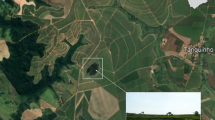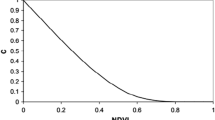Abstract
Rainfall leading to a variation of the groundwater regime has been considered as a main factor that caused slope failures in many regions in the world, particularly in Tunisia, where roads were recently well damaged under intensive precipitations. The installation of drilled horizontal drain can be an improvement alternative technique which affects the flow path, reduces the pressure in the soil by reducing the groundwater location. This study examines the effectiveness of drilled horizontal drains to stabilize the residual slope in a physical model. This is conducted in relation to the water retention property of the soil. So, in this study, different types of soils characterized by their corresponding water retention curves were considered. Using the proposal model implemented in CODE-BRIGHT software, we discuss many of the issues of the drain’s efficiency basing on the water pressure and the displacement field changes. The paper discusses also the role of the main parameters which characterize the water-retention of the soil, such volumetric water content at saturation and air-entry suction.



















Similar content being viewed by others
References
Batali L, Andreea C (2016) Slope stability analysis using the unsaturated stress analysis: case study. Procedia Eng 143:284–291
Bishop AW (1959) The principle of effective stress. Tecnisk Ukeblad 39:859–863
Borja RI, Liu X, White JA (2012) Multiphysics hillslope processes triggering landslides. Acta Geotech 7(4):261–269
Brooks RH, Corey AT (1964) Hydraulic properties of porous media, Hydrology Paper No 3. Colorado State University. 27 pp
Cai F, Ugai K, Wakai A, Li Q (1998) Effects of horizontal drains on slope stability under rainfall by three-dimensional finite element analysis. Comput Geotech 23(4):255–275
Cuomo S, Della Sala M (2013) Rainfall-induced infiltration runoff and failure in steep unsaturated shallow soil deposits. Eng Geol 162:118–127
Damiano E, Olivares L (2010) The role of infiltration processes in steep slope stability of pyroclastic granular soils: laboratory and numerical investigation. Nat Hazards 52:329–350. https://doi.org/10.1007/s11069-009-9374-3
Damiano E, Olivares L, Picarelli L (2012) Steep-slope monitoring in unsaturated pyroclastic soils. Eng Geol. https://doi.org/10.1016/j.enggeo.2012.03.002
Dan HC, Xin P, Li L, Li L, Lockington D (2012) Capillary effect on flow in the drainage layer of highway pavement. Can J Civ Eng 39:654–666. https://doi.org/10.1139/L2012-050
Fredlund DG, Xing A (1994) Equations for the soil-water characteristic curve. Can Geotech J 31(3):521–532
Fredlund DG, Xing A, Fredlund MD, Barbour SL (1995) The relationship of the unsaturated soil shear strength to the soil-water characteristic curve. Can Geotech J 32(3):440–448
Fredlund DG, Morgenstern NR, Widger RA (1978) Shear strength of unsaturated soils. Can Geotech J 15(3):313–321
Hamrouni F, Trabelsi H, Jamei M, Olivella S (2019) Numerical analysis of landslides caused by rainfall in a reduced physical slope model. Eur J Environ Civ Eng. https://doi.org/10.1080/19648189.2019.1580223
Iryo T, Kerry RR (2003) On the hydraulic bahavior of unsaturated nonwoven geotextiles. Geotext Geomembr 21:381–404. https://doi.org/10.1016/S0266-1144(03)00046-3
Jamei M, Guiras H, Olivella S (2015) Analysis of slope movement initiation induced by rainfall using the elastoplastic barcelona basic model. Eur J Environ Civ Eng. https://doi.org/10.1080/19648189.2014.996670
Jamei M, Hamrouni F, Trabelsi, H. (2017) Application of the hydraulic gradient method for physical modeling of rainfall induced landslide: the optimal design for a physical laboratory model. JTC1 Workshop on advances in landslide understanding Barcelona, Spain.
Kakogiannou E, Sanavia L, Nicot F, Darve F, Schrefler BA (2016) A porous media finite element approach for soil instability including the second-order work criterion. Acta Geotech 11(4):805–825
Karube D, Kawaï K (2001) The role of pore water in the mechanical behavior of unsaturated soils. Geotech Geol Eng 19:211–241. https://doi.org/10.1023/A:1013188200053
Kawaï K, Karube D, Kato S (2000) The model of water retention curve considering effect of void ratio. Balkema, Unsaturated soil for Asia, pp 329–334
Kim J, Kim Y, Jeong S, Hong M (2017) Rainfall-induced landslides by deficit field matric suction in unsaturated soil slopes. Environ Earth Sci. https://doi.org/10.1007/s12665-017-7127-2
Klubertanz G, Bouchelaghem F, Laloui L, Vulliet L (2003) Miscible and immiscible multiphase flow in deformable po-rous media. Math Comput Model 37:571–582
Laloui L, Nuth M (2009) On the use of the generalized effective stress in the constitutive modeling of unsaturated soils. Comput Geotech 36:20–23. https://doi.org/10.1016/j.compgeo.2008.03.002
Nuth M, Laloui L (2008) Effective stress concept in unsaturated soils: clarification and validation of a unified framework. Int J Numer Anal Meth Geomech 32:771–801. https://doi.org/10.1002/nag.645
Olivella S, Gens A, Carrera J, Alonso EE (1996) Numerical formulation for simulator (CODE_BRIGHT) for coupled analysis of saline media. Eng Comput 13:87–112
Orense RP, Shimoma S, Maeda K, Towhata I (2004) Instrumented model slope failure due to water seepage. J Nat Dis Sci 26(1):15–26
Rahardjo H, Fredlund D G, Vanapalli S K.(1992) Use of linear and nonlinear shear strength versus matric suction relations in slope stability analyses. Sixth International symposium on landslides Christchurch p 531–537.
Rahardjo H, Hritzuk KJ, Leong EC, Rezaur RB (2003) Effectiveness of horizontal drains for slope stability. Eng Geol 69:295–308. https://doi.org/10.1016/S0013-7952(02)00288-0
Rahimi A, Rahardjo H, Leong EC (2010) Effect of hydraulic properties of soil on rainfall-induced slope failure. Eng Geol 114:135–143
Romero E, Vaunat J. (2000) Retentions curves of deformable clays. Dans experimental evidence and theoretical approaches in unsaturated soils. Balkema
Sanavia L (2009) Numerical modelling of a slope stability test by means of porous media mechanics. Eng Comput 26(3):245–266
Qi Shunchao & Vanapalli Sai K (2018). Simulating hydraulic and mechanical responses of unsaturated expansive soil slope to rainfall: case study. International Journal of Geomechanical.
Thuo JN, Yang KH, Huang CC (2015) Infiltration into unsaturated reinforced slopes with nonwoven geotextile drains sandwiched in sand layers. Geosynth Int 22(6):457–474. https://doi.org/10.1680/jgein.15.00026
Van Genuchten MTH (1980) A closed-form equation for predicting the hydraulic conductivity of unsaturated soils. Soil Sci Soc Am J 44:892–898. https://doi.org/10.2136/sssaj1980.03615995004400050002x
Vanapalli SK, Fredlund DG, Pufahl DE, Clitton AW (1996) Model for the prediction of shear strength with respect to soil suction. Can Geotech J 33:379–392
Yechezkel M (1978) Hydraulic conductivity of unsaturated porous media: generalized macroscopic approach. Water Resour Res 14:325–334
Zhang LL, Fredlund DG, Fredlund Murray D, Wilson GW (2014) Modeling the unsaturated soil zone in slope stability analysis. Can Geotech J 51(12):1384–1398
Zhou J, Yu JL (2004) Influences affecting the soil-water characteristic curve. J Zhejiang Univ Sci 6(8):797–804
Zienkiewicz OC, Cormeau IC (1974) Visco-plasticity-plasticity and creep in elastic solids – A unified numerical solution approach. Int J Numer Meth Eng 8:821–845
Acknowledgements
The authors express their gratitude for the scientific members of the Civil Engineering Laboratory from the National Engineering School of Tunis who supported and encouraged this research.
Author information
Authors and Affiliations
Corresponding author
Additional information
Publisher's Note
Springer Nature remains neutral with regard to jurisdictional claims in published maps and institutional affiliations.
Rights and permissions
About this article
Cite this article
Hamrouni, F., Trabelsi, H. & Jamei, M. Numerical Analysis of the Drilled Horizontal Drains Efficiency in Physical Slope Model: The Role of the Soil Water Retention Property. Geotech Geol Eng 40, 195–211 (2022). https://doi.org/10.1007/s10706-021-01894-w
Received:
Accepted:
Published:
Issue Date:
DOI: https://doi.org/10.1007/s10706-021-01894-w




